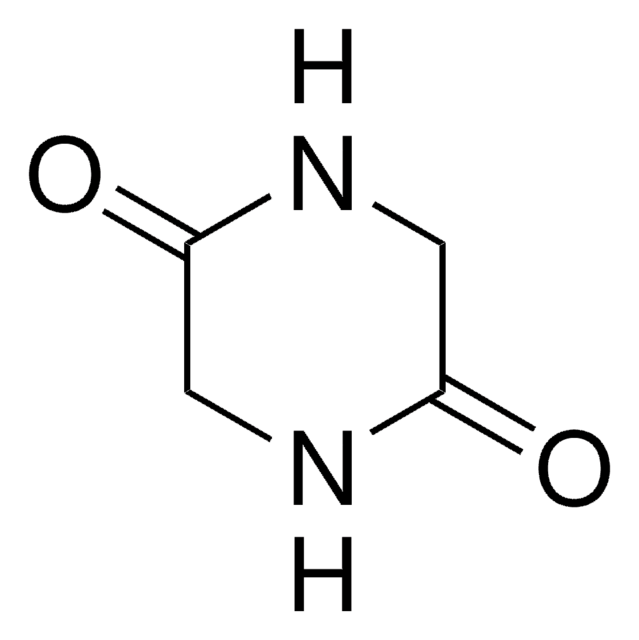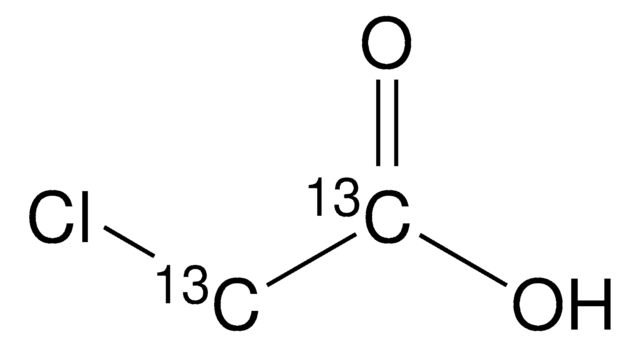추천 제품
일반 설명
Chloroacetic acid (CAA, monochloroacetic acid, MCAA) is a halogenated aliphatic carboxylic acid. Its mutagenic effects have been studied in Rattus norvegicus. The rate of degradation of MCA by photocatalysis using TiO2 at pH 3 is reported to be enhanced under the influence of ozone. It is an irritant that hydrolyzes proteins resulting in degradation of the cells. This property has been applied in treating plantar warts.
애플리케이션
Chloroacetic acid may be used to synthesize the following:
- Thiocarbamoylthioacetic acid derivatives.
- 4-Thiazolone derivatives.
- Triazinothiazolone derivatives.
- Water soluble carboxymethyl chitosan.
면책조항
“The product is not intended for use as a biocide under global biocide regulations, including but not limited to US EPA′s Federal Insecticide Fungicide and Rodenticide Act, European Biocidal Products Regulation, Canada’s Pest Management Regulatory Agency, Turkey’s Biocidal Products Regulation, Korea’s Consumer Chemical Products and Biocide Safety Management Act (K-BPR) and others.”
신호어
Danger
유해 및 위험 성명서
Hazard Classifications
Acute Tox. 3 Dermal - Acute Tox. 3 Inhalation - Acute Tox. 3 Oral - Aquatic Acute 1 - Eye Dam. 1 - Skin Corr. 1B - STOT SE 3
표적 기관
Respiratory system
Storage Class Code
6.1A - Combustible acute toxic Cat. 1 and 2 / very toxic hazardous materials
WGK
WGK 3
Flash Point (°F)
258.8 °F - closed cup
Flash Point (°C)
126 °C - closed cup
개인 보호 장비
dust mask type N95 (US), Eyeshields, Faceshields, Gloves, type P2 (EN 143) respirator cartridges, type P3 (EN 143) respirator cartridges
이미 열람한 고객
ZnO/carboxymethyl chitosan bionano-composite to impart antibacterial and UV protection for cotton fabric.
Shafei AE and Abou-Okeil A.
Carbohydrate Polymers, 83(2), 920-925 (2011)
A Novel Three-Component Synthesis of Triazinothiazolones.
Holla BS, et al.
Synthetic Communications, 35(3), 333-340 (2005)
Desulfurization of N-Substituted 2-Thioxothiazolidin-4-ones in Aqueous Solutions of Chloroacetic Acid.
Orlinskii MM.
Russ. J. Org. Chem., 34(12), 1805-1806 (1998)
Mohammad Faisal Siddiqui et al.
Ecotoxicology and environmental safety, 65(2), 159-164 (2006-05-02)
Chloroacetic acid (CAA) and chlorobenzene (CB) have been evaluated for in vivo mutagenic potential in Rattus norvegicus, employing the following criteria : (i) chromosomal aberrations (CAs) such as breaks, gaps, exchanges, rings, and multiple aberrations and (ii) micronuclei (MN) induction.
Novel thiazolone derivatives of N-aryl-β-alanines.
Stasevych M, et al.
Chemistry of Heterocyclic Compounds, 47(8), 1050-1052 (2011)
자사의 과학자팀은 생명 과학, 재료 과학, 화학 합성, 크로마토그래피, 분석 및 기타 많은 영역을 포함한 모든 과학 분야에 경험이 있습니다..
고객지원팀으로 연락바랍니다.











